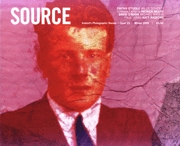Emerging Perspectives
'Perspective 2000' was at The Ormeau Baths Gallery 7th September - 14th October 2000
Review by Slavka Sverakova
Issue 25 Winter 2000
View Contents ▸
Nine out of the twenty nine artists selected by Lynne Cooke for this year's Perspective exhibition, from over 330 submissions, are photographers. The history of photography had been characterized by comparison with painting and by an entrenchment in debates about the 'real','truth' and 'representation'. The way in which photography contests its representational role, is a measure of it being like contemporary art practices that allow a meaning to slide.
As a medium, in Cooke's choice, these photographs point to their (implied) capacity to claim the future of visual culture through digital prints and computer aided work. Accessibility, ease of dissemination and the ambiguous claim of each print that it is an 'original', all make photography eminently suitable for the new technology. Their promiscuous relationship with authenticity is now often the most important guarantor of value.
All but one contributor (Geroen Offerman, Plant 2000) exhibited sets of photographs of 2, 3, 4, 5, 10, 11, and 16 prints. I do not see any significance in particular numbers, I do see significance in the preference for companion images like in Chardin (Justine Carter, Brendan Earley) or polyptychs like in medieval paintings, e.g. Giotto, piero della Francesca etc (John Duncan, John paul McAree, Stuart Gurden). The triptych model (Christopher Ould, Brendan Earley) has been appropriated again in the late 20th Century by Francis Bacon. The preference for four views (Darah McGrath, Susan Morris) may be guided by a desire for some type of symmetry, or wanting to give each work more independence from the rest of the set. This seems to be the case when the dimensions vary. The five pinhole prints by Kate Byrne exhibit none of the above assurances. The beautiful, haunting, curved universe of her Trace series may include either three images if the motif is the determinant (handbag, glove, shoe) or many more images if the visual closure and distances be varied. This insecurity of a set is not a defective feature. On the contrary, it controls the looking by submitting the retinal to the speculative. A large handbag at a distance projects the same image on the retina as a small handbag nearby (given that we do not move). A secure set of two will facilitate straight comparison. An insecure set, say of one or three, increases the ambiguity of the image and fragmentation of the retinal projections. We have to speculate. The modularity of vision becomes a cascade. Image: Kate Byrne from the series 'Trace'
Image: Kate Byrne from the series 'Trace'
Photography is also an operation in remembering. Is memory partial to representation of the experienced? The various skids and slides in what we remember would point to such fragmentation of the experience as to refute any possibility of an image having anything to do with it. Yet we look at postcards, photographs, videos to trigger off data that are not even present in them. The photograph's ability to present that which is absent from it pulls the argument away from re-presentation, as if the printed image were a referent matrix for other fragments of the world to land on. lf so, then such an image is both complete (as an attractive matrix) and incomplete (as attracting other fragments of existence). If an image is both complete and incomplete, its meaning must be both too. Derrida proposed an indefinite postponement of the formation of meaning as movement inscribed in any aesthetic text (text here is a mode of appropriation of the real). Although I enioy his rehearsing Zeno's paradox, I prefer another position: emergence, submerging and merging of meanings. I see two advantages in this: one, it quickly sorts out the chaff from the grain and two, it liberates me from static states of mind. Consequently, I am never between two meanings, I slip from one to another. The process is undisputed in interpretation of music. The mimesis in visual arts undermines its application. Nevertheless, for example in Byrne's image of a handbag there are two possible readings: a monstrous object in a moon landscape, or a handbag on a beach. They are mutually exclusive and dynamically bound, so that I select one meaning knowing that the change is unavoidable.
We do not know how it works exactly, but we do have some experience of It. If you can accept the above, you should be able to accept that a photograph does not represent, on the contrary, that it presents.
The sets in Perspective 2000 for example present an investigation of simultaneity in a way not open to words, e.g. four border crossings, two details of a forest, sixteen views of Berlin, eleven of Belfast etc. The cropped and blurred enclosures present the illusion of thrilling closeness to the 'real' in the image, when we are nowhere near it. Such photographs replace reality with convincing lies for a particular purpose. The photographers offer a glorious oscillation between two types of perception, the rapid discrimination of fine details and constructs of meanings.
Other articles by Slavka Sverakova:
Other articles on photography from the 'Multi-Genre' category ▸






